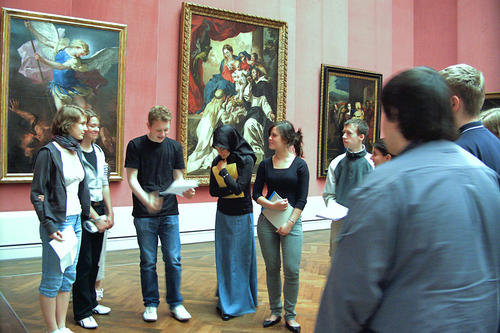More than Just Decoration
Art historians and education scholars at Freie Universität impart “education through art” at schools
Feb 23, 2015
Museums as classrooms: Students from Berlin’s Beethoven School visited the Gemäldegalerie art museum in Berlin as part of the “Bildung durch Bilder” (Art in Education) project – and would have liked to stay there.
Image Credit: Schleußner/Beethovenschule
Louis XIV is a powerful man. Left hand on his hip, a jewel-encrusted sword hanging at his belt, surrounded by marble and royal purple drapes. That, at least, is how the French “Sun King” had himself immortalized on canvas, around 1700.
For those in power today, the settings chosen for this kind of display in the era of absolute monarchy may seem a bit much. But how do today’s “rulers” present themselves? How does someone like the President of Germany allow himself to be photographed? After all, then as now, a picture is worth a thousand words.
Questions like these are the subject of the transfer project “Bildung durch Bilder” (Art in Education) undertaken by the research group “BildEvidenz. History and Aesthetics.” With funding from the German Research Foundation (DFG) for an initial period of three years, the group includes art historians and specialized scholars of education at Freie Universität Berlin, who are teaching students at schools in Berlin and Brandenburg the skills they need in order to work with images and media. The project extends to six academic secondary schools, where students are tasked with not only exploring the images’ aesthetic effect, but also learning and thinking critically about their historical, cultural, and social dimensions.
“We want the students to develop an awareness that images are not just decoration for texts, but instead have a value and significance all their own,” says Klaus Krüger, a professor of art history at Freie Universität and the head of the project. In joint seminars, university students of art history and those studying to become teachers of history and German work together to develop methods of fostering the skills needed to work with images in schools – and not only in art class, but also in German and history, provided that these activities fit with the regular instructional material.
Traditional Reading, Reinterpreted
School classrooms used to be largely uncharted territory for the scholars of art history, since the discipline is not taught in schools, nor is there a specific program geared toward teaching it. “We’re very happy to have brought in the history and German teaching units from Freie Universität as project partners,” says art historian Karin Kranhold, who is in charge of the project’s organizational and conceptual side.
Martin Lücke, a professor of history education, sees the transfer project as filling a gap in instruction on the teaching of history and in history instruction itself: “In the classroom and in many school history textbooks, images are still often used today as mere illustrations of the past,” he says. “Their value as sources is seldom discussed, not to mention their art history dimension,” Lücke adds.
Elisabeth Paefgen, a professor of the teaching of German language and literature at the Institute of German and Dutch Languages and Literatures at Freie Universität, has also long argued in favor of a sharper focus on the meaning of images in education. She says German is a good discipline for this kind of approach: “Traditional readings like Theodor Fontane’s Effi Briest or Thomas Mann’s Buddenbrooks can be reinterpreted using the painting In the Conservatory, by Édouard Manet,” Paefgen says. The 1879 painting shows a thoughtful married couple who give an impression of separation and detachment. Paefgen sees this as a good supplement to students’ interpretation of marital conflicts and relationships between couples, key themes in these literary works.
Students Didn’t Want to Leave the Museum
The basis for the transfer project was created back in 2006, when the “Denkwerk Kunstgeschichte” project was initiated with support from the Robert Bosch Stiftung. It started out as a cooperative project with 14 schools in Berlin und Brandenburg, with about 1,500 students in grades 5 through 12 participating in over 60 projects in all.
“In the five years that the Denkwerk project ran, we explored how cooperation between the art history institute and schools can work,” Kranhold reports. Instructional units ranged from scholarly presentations at school auditoriums to investigating the architectural history of the school building and beyond, including field trips to Charlottenburg Palace or museums in Berlin. The project was so well received by students and teachers that Krüger had to leave the Gemäldegalerie art museum, in Berlin, on his own after one field trip: “The students simply wanted to stay longer,” he says.
In the current project, the art historians and scholars of education also hope to include aspects that are part of the young people’s direct real-life experience: There are plans to discuss music videos, photographs, and American TV series alongside religious caricatures that have appeared in newspapers.
“This would be a good way to look at the history of banning of images, or the iconoclastic activity that took place during the Reformation period,” Krüger says. During this period, known as the Bildersturm (“image storm”), paintings depicting saints and other works of art were removed from churches and in some cases even destroyed. Krüger says this is also a way to raise awareness of cultural heritage among young people, adding that it is always a wonderful feeling “when students experience this ‘aha’ moment and suddenly start to perceive their surroundings differently.”
Schools involved in the project
Beethoven-Schule (Lankwitz)
Ernst-Haeckel-Gymnasium (Werder/Havel)
Hildegard-Wegscheider-Gymnasium (Grunewald)
Königin-Luise-Stiftung (Dahlem)
Melanchthon-Schule (Hellersdorf)
Schulfarm Insel Scharfenberg (Reinickendorf)
Further Information
- Klaus Krüger, Professor of Art History, Freie Universität, and Director of the Project, Email: kkrueger@zedat.fu-berlin.de
- Martin Lücke, Professor of History Education, Freie Universität, Email: martin.luecke@fu-berlin.de
- Elisabeth Paefgen, Professor of German Language and Literature, Institute of German and Dutch Language and Literature, Freie Universität, Email: paefgen@germanistik.fu-berlin.de

